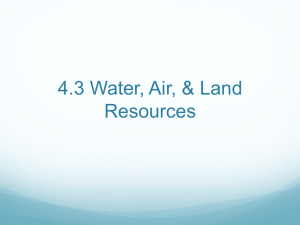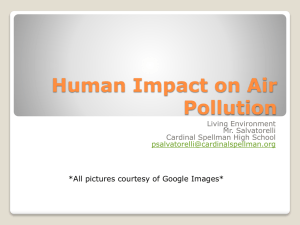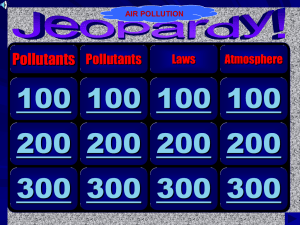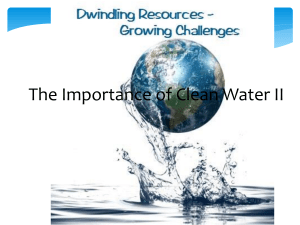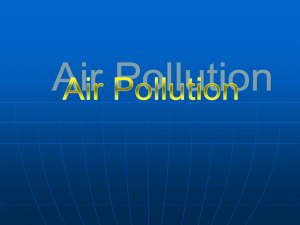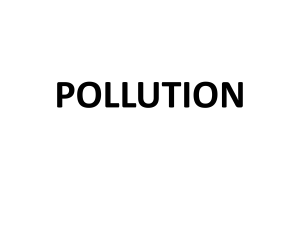AIR POLLUTION sunum
advertisement
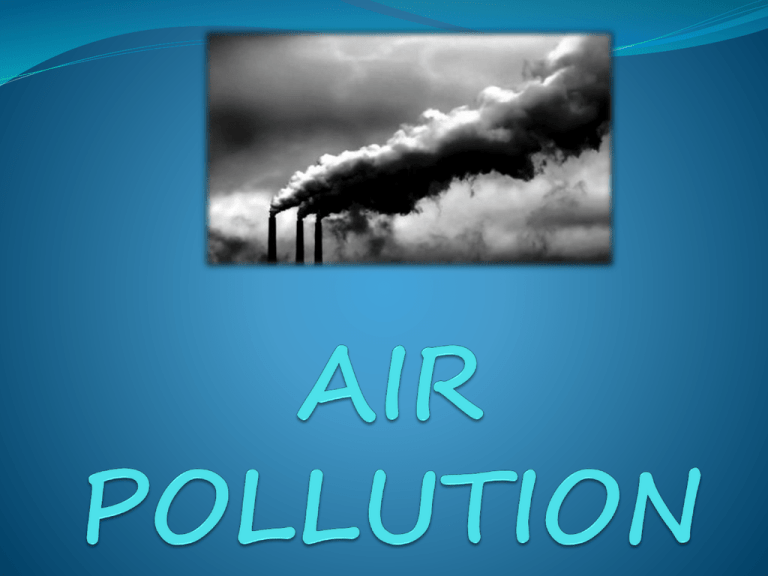
WHAT IS AIR POLLUTION? *Air is the ocean we breathe. Air supplies us with oxygen which is essential for our bodies to live. Air is 99.9% nitrogen, oxygen, water vapor and inert gases. Human activities can release substances into the air, some of which can cause problems for humans, plants, and animals. HISTORY OF AIR POLLUTION Industrial Revolution during the 18th and 19th centuries was based on the use of coal. in the Middle Ages the use of coal in cities such as London was beginning to escalate. Industriess were often located in towns and cities, and together with the burning of coal in homes for domestic heat, urban air pollution levels often reached very high levels. During the first part of the 20th century, tighter industrial controls lead to a reduction in smog pollution in urban areas What is and what is not an air pollutant. Many of the things generally considered pollutants are present in the natural air. Three T’�s in the atmosphere tonnage, toxicity time AIR POLLUTANTS Three widespread air pollutants cause the most damage to the environment and human health: Sulfur dioxide (SO2) Nitrogen oxides (NOx). Particulate matter (PM) TYPES OF AIR POLLUTION Indoor Air Pollution Many people spend large portion of time indoors - as much as 80-90% of their lives. We work, study, eat, drink and sleep in enclosed environments where air circulation may be restricted. For these reasons, some experts feel that most of the people suffer from the effects of indoor air pollution more than outdoor pollution. Tobacco smoke, cooking and heating appliances, and vapors from building materials, paints, furniture, etc. cause pollution inside buildings. Outdoor pollution Smog is a type of large-scale outdoor pollution. It is caused by chemical reactions between pollutants derived from different sources, primarily automobile exhaust and industrial emissions. CAUSES OF AIR POLLUTION Power plants Transportation Light pollution Burning of solid waste POWER PLANTS Represent a very grim sector of business when it comes to the contribution to air pollution. TRANSPORTATION The growing use of old, poorly maintained passenger cars and the use of diesel fuel have dramatically worsened air quality. LIGHT POLLUTION The lightening of the night sky due to artificial light being scattered about BURNING OF SOLID WASTE Hundreds of millions of tons of solid waste are collected and disposed of each year. We All Cause Air Pollution! directly through our use of electricity, fuels, and transportation. indirectly, when we buy goods and services that use energy in their production and delivery the burning of fossil fuels, such as coal, oil, natural gas, and gasoline to produce electricity and power our vehicles. RESULTS OF AIR POLLUTION 1. GLOBAL WARMING 2.ACID RAIN 3.HEALTH EFFECTS 4.OZONE DEPLETION 1.GLOBAL WARMING Air pollution includes greenhouses gases (carbondioxide,water vapor,methane..) Greenhouse gases are a natural part of Earth’s atmosphere. Greenhouse gases cause global warming by trapping heat from the Sun in the Earth’s atmosphere 2.ACID RAIN Acid rain occurs when emissions of sulfur dioxide or nitrogen oxides in the atmosphere react with water, oxygen, and oxidants to form acidic compounds. 3. HEALTH EFFECTS SHORT-TERM HEALTH EFFECTS Irritation to the eyes, nose and throat bronchitis and pneumonia, headaches, nausea, and allergic reactions. LONG-TERM HEALTH EFFECTS Chronic respiratory disease, lung cancer, heart disease, and even damage to the brain, nerves, liver, or kidneys. 4. OZONE DEPLETION Ozone layer acts protective blanket for earth, shields earth from harmful UV radiation of the sun adversly affected by air pollution. (CFC chloroflorocarbon,aerosol) SOLUTIONS Save energy Choose recycled products Use public form of transport Reduce the use of aerosols Do not smoke DO YOU KNOW? The health costs of human exposure to outdoor air pollutants range from $40 to $50 billion. An estimated 50,000 to 120,000 premature deaths are associated with exposure to air pollutants. People with asthma experience more than 100 million days of restricted activity, costs for asthma exceed $4 billion, and about 4,000 people die of asthma.




